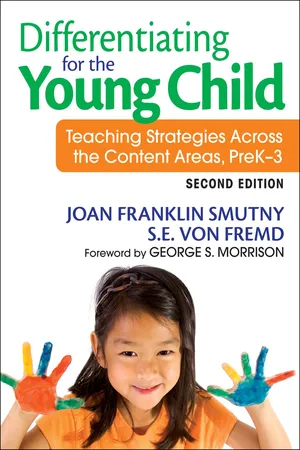
Differentiating for the Young Child
Teaching Strategies Across the Content Areas, PreK–3
- 280 pages
- English
- ePUB (mobile friendly)
- Available on iOS & Android
Differentiating for the Young Child
Teaching Strategies Across the Content Areas, PreK–3
About this book
Praise for the first edition:
"Smutny and von Fremd?s very special talent is in helping adults nurture and cherish the creativity and learning joy that is so intrinsic in young children."
—Susan Winebrenner, Author and Staff Development Specialist
Education Consulting Service, Inc.
"The authors use teacher voices, classroom stories, and solid foundations to guide the reader?s thinking. Practical examples and specific guidelines make the book very useful without resorting to templates or gimmicks!"
—Carol Ann Tomlinson, Professor
University of Virginia
Praise for the second edition:
"Using the ideas presented in this book make teaching and learning more personalized and exciting for both teachers and their students. This book provides a breath of fresh air for the teaching profession!"
—Carole S. Campbell, Educator
Higher Ground Educational Consulting
"This book is chock full of great examples and classroom applications, providing specific guidance and clear-headed advice."
—Nancy H. McDonough, Second-Grade Teacher
Walter Stillman School, Tenafly, NJ
Meet the highly diverse needs of primary students with these differentiated teaching strategies!
Every student who walks through the classroom door brings special gifts to the learning table. Differentiating for the Young Child helps primary teachers value and support the unique experiences and learning styles of diverse young learners.
Joan Franklin Smutny and S.E. von Fremd offer strategies and methods for promoting creative thinking and intellectual discovery across key discipline areas. They also tackle issues relating to underserved students and discuss differentiated technology use. Revised to make differentiated learning easier, this second edition:
- Includes new charts with high- to low-preparation strategies for differentiating lessons in math, science, social studies, and language arts
- Presents new focus questions to help teachers clarify their own priorities and target student needs efficiently
- Offers Web sites for further reference
Because the primary grades influence all the years that follow, this resource helps early childhood and primary teachers use creative, differentiated teaching strategies to meet the individual learning needs of all young children and encourage their future academic success.
Frequently asked questions
- Essential is ideal for learners and professionals who enjoy exploring a wide range of subjects. Access the Essential Library with 800,000+ trusted titles and best-sellers across business, personal growth, and the humanities. Includes unlimited reading time and Standard Read Aloud voice.
- Complete: Perfect for advanced learners and researchers needing full, unrestricted access. Unlock 1.4M+ books across hundreds of subjects, including academic and specialized titles. The Complete Plan also includes advanced features like Premium Read Aloud and Research Assistant.
Please note we cannot support devices running on iOS 13 and Android 7 or earlier. Learn more about using the app.
Information
1 | Preparing for the Journey of a Differentiated Classroom |

Worlds of Wisdom and Wonder, The Center for Gifted
THE METAPHOR OF A “JOURNEY”
- How prepared are my children, and what do they need to complete this journey?
- What sights and experiences do I want all of them to have no matter which route they take?
- What routes would best serve their needs (a direct route or a longer itinerary that covers more ground)?
- What should be the means of traveling (car, bike, foot, etc.)?
- How will I know if the journey accomplished what I intended?
THE LEARNING JOURNEY
- Are they prepared for the journey? What skills, abilities and equipment do they have?
- What special problems or challenges do they bring to the journey?
- What differences from cultural background, life experience, and home life influence their ability to embark on this journey (i.e., learn)?
- What do you as teachers bring to this journey (knowledge, skills, experience, interests, resources) and what do you need (what accommodations to your style and preferences, what adjustments due to time constraints and other demands)?
- Where do you want the children to be at the end of this journey (i.e., what do you want the students to understand or to be able to do)?
- What territory (content) will they cover in terms of knowledge gained and skills honed?
- What learning standards and curriculum goals will this journey address?
- What behaviors and comments would show you that the students have reached their destination (achieved their goals)?
- What products, performances, constructions, and experiments would express understanding of the concepts, skills, and information taught?
- How should the journey begin (what catalysts should be introduced)?
- What teaching strategies should be applied?
- What learning activities should be used?
- What resources should be drawn upon?
- How will the environment be designed and managed?
- What are the criteria for knowing that the children have reached the destination (understood the concepts and processes involved)?
- What behaviors and verbal and written responses will reveal that learning has taken place?
- What measures (e.g., observation, questioning, rubrics) will give you the information you need to know if the child is on track or if he or she needs further adjustment?
Example: Use of Learning Stations
Example: Use of Creativity
Table of contents
- Cover Page
- Title
- Copyright
- Contents
- Foreword by George S. Morrison
- Acknowledgments
- About the Authors
- Introduction
- 1. Preparing for the Journey of a Differentiated Classroom
- 2. Assessing Primary Learners
- 3. Strategies for Differentiating the Learning Journey
- 4. Using the Arts to Differentiate the Primary Curriculum
- 5. Differentiated Instruction Applied to Language Arts
- 6. Differentiated Instruction Applied to Social Studies
- 7. Differentiated Instruction Applied to Science
- 8. Differentiated Instruction Applied to Mathematics
- Bibliography
- References
- Index